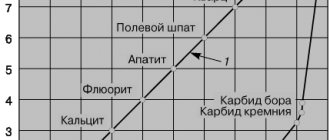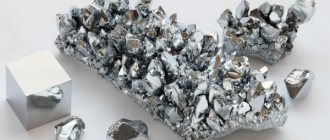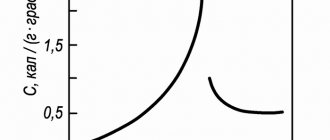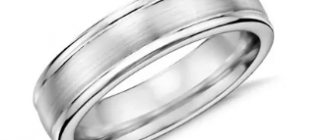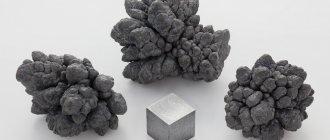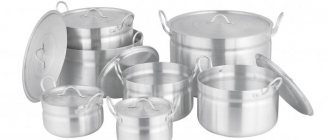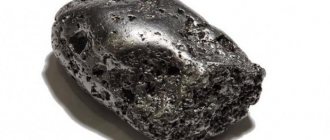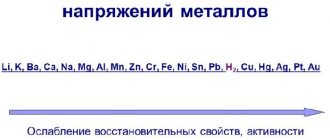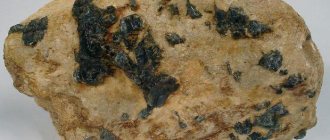Main groups of metals in industry
The industry divides metals into large groups:
- Black.
- Colored lungs.
- Colored ones are heavy.
- Noble.
- Rare earth and alkaline.
Black metals
This group includes iron, manganese, chromium and their alloys. The group also includes steels, cast irons and ferroalloys. These substances have good electrical conductivity and unique magnetic characteristics.
Black metals
Ferrous metals cover up to 90% of the world's demand for metal products.
Light non-ferrous metals
They are characterized by low density. The group includes aluminum, titanium, magnesium. These are less common than iron and are more expensive to mine and manufacture. They are used where the low weight of a product or part pays off its high cost - in aircraft construction, electronics production, and in the communications industry.
Light non-ferrous metals
Titanium does not cause rejection by the immune system and is used in bone tissue prosthetics.
Heavy non-ferrous metals
These are elements with a high specific gravity, such as copper, tin, lead, zinc and nickel. They have good electrical conductivity.
Copper Tin Zinc Lead Pure Nickel
They are widely used as reaction catalysts in the manufacture of electrical materials, electronics, transport - wherever sufficiently strong, elastic and corrosion-resistant materials are required.
Noble metals
This group includes gold, silver, platinum, as well as rare ruthenium, rhodium, palladium, osmium, and iridium. They have the highest specific gravity, high corrosion resistance and high electrical and thermal conductivity.
Gold and platinum
Silver
At the dawn of mankind, gold, silver and platinum were used as a universal payment instrument and as a means of accumulating wealth. With the development of the digital economy and the transition of payments to virtuality, their unique physical properties are more important than flocks
Rare earth and alkaline
Rare earth elements include scandium, yttrium, lanthanum and 15 other rare elements. These elements have a significant specific gravity, high chemical activity and are used in high-tech industries.
Yttrium
Scanidium
Lanthanum
Alkaline materials include lithium, potassium, sodium and others. All of them are distinguished by their low specific gravity and exceptional chemical activity and, when reacting with water, form alkalis, which are widely used in everyday life and industry as part of soap and other detergents.
Alkali metals
Classification of metals by chemical composition
The chemical properties of pure elements are determined by the structure of the atoms of real metals and, above all, by their atomic number, which characterizes their ability to react with hydrogen, oxygen and other elements. The chemical characteristics of actually used metals can differ greatly from the parameters of a pure substance, both for the better and for the worse.
Undesirable additives are called impurities, and those that are introduced deliberately to change parameters in the desired direction are called alloying additives.
The generally accepted classification is based on the indication of the main component of the alloy.
Chemical properties of silver:
| 300 | Chemical properties | |
| 301 | Oxidation states | -2, -1, +1, +2, +3 |
| 302 | Valence | I, II, III |
| 303 | Electronegativity | 1.93 (Pauling scale) |
| 304 | Ionization energy (first electron) | 731 kJ/mol (7.576234(25) eV) |
| 305 | Electrode potential | Ag+ + e— → Ag, Eo = +0.799 V, Ag2+ + e— → Ag+, Eo = +2.00 V |
| 306 | Electron affinity energy of an atom | 125.6 kJ/mol |
Atomic-crystalline structure of metals
The internal structure of metals and their characteristics determine their physical and chemical properties. Electrons in the outer orbits of atoms are weakly bound to the nucleus and have a negative charge. When there is a potential difference, electrons migrate to the positive pole, creating an electric current. This physical phenomenon causes electrical conductivity.
The crystalline structure is characteristic of metals and their alloys in the solid phase state. Atoms are arranged in a certain three-dimensional structure called a crystal lattice. The number of atoms at the vertices and faces of this structure, as well as the distance between them, determines such physical properties of the metal as electrical and thermal conductivity, viscosity, fluidity, etc. The crystal structure of metals and alloys can be of two types:
- The interatomic distance is the same in all directions. This is the so-called isotropic structure. Moreover, the physical properties of the crystal are also the same in all directions.
- The interatomic distance horizontally and vertically is different. Such a crystal is called anisotropic, and its physical parameters vary depending on the direction.
Atomic crystal structure of metals
In a real piece of metal, composed of many isolated crystalline fragments, the atomic-crystalline structure belongs to the third type - quasi-isotropic. On average, the properties of such a piece are close to isotropic. When building a crystal lattice, some atoms do not fall into place, are displaced or lost. In this case, they speak of defects in the crystalline structure of metals. Structural defects negatively affect the properties of the product, especially if it must be a single crystal, as, for example, in electronics, laser technology and other high-tech industries.
Face-centered lattice
The crystal structure of metals having a face-centered cubic lattice is the following structure. This is a cube that includes fourteen atoms. Eight of them form lattice nodes, and another six are located, one on each face.
They have a similar structure:
The main distinctive properties are shine of different colors, lightness, strength, malleability, increased resistance to corrosion.
Physical properties of metals
Physical properties are determined by the internal structure of metals.
The main difference between metals and other elements is their electrical conductivity and magnetic properties.
And although scientists have created non-metallic materials that have a different structure but the same properties as metals and alloys, they are still too expensive for mass use. Many chemically pure metals have insufficient strength for practical applications; to remedy the situation, their alloys are used in technology and construction.
Physical properties of metals
The addition of certain additives leads to an increase in the strength of the resulting substance tens of times relative to the original element.
Electronic structure of metals and their features
The internal structure of real metals determines their physical and chemical parameters.
Crystal lattice of metals
All metals in the solid phase have a crystalline structure. This spatial formation of repeatedly repeating primary structures is called a crystal lattice. crystal lattice diagram.
Crystal structure of metals
The crystal structure of metals and alloys can be of two types:
- The interatomic distance is equal in all directions. This is the so-called isotropic structure. Moreover, the physical properties of the crystal are also the same in all directions.
- The interatomic distance horizontally and vertically is different. Such a crystal is called anisotropic; its parameters depend on the direction.
In a real piece of metal, which consists of many crystalline fragments, the atomic-crystalline structure belongs to the third type - quasi-isotropic. The averaged parameters of such a piece are close to isotropic.
Body-centered lattice
The structure of the crystal lattice of metals of this type is the following structure. This is a cube with eight atoms at its nodes. Another one is located in the center of the free internal space of the cell, which explains the name “body-centered”.
This is one of the options for the simplest structure of the unit cell, and therefore the entire lattice as a whole. The following metals have this type:
- molybdenum;
- vanadium;
- chromium;
- manganese;
- alpha iron;
- beta iron and others.
The main properties of such representatives are a high degree of malleability and ductility, hardness and strength.
Types of crystal lattices
The distance between neighboring atoms is called the lattice parameter; for different metals it is 2 - 6 angstroms. There are three main types of crystal lattices:
- Cubic: body-centered - contains nine atoms. Characteristic of iron, chromium, molybdenum, and vanadium.
- Cubic face-centered: already includes 14 atoms. Inherent in copper, gold, lead, aluminum.
- Hexagonal: there are already 17 atoms and they are placed most densely. This is how magnesium, zinc, cadmium and others crystallize.
The unique feature of iron is that up to 910°C it has a body-centered cubic structure, and when heated above this temperature it becomes face-centered.
Crystal structure of alloys
An alloy is a material consisting of two or more chemical elements. It may contain both metals and non-metals. For example, bronze is an alloy of copper and tin, and cast iron is an alloy of iron and carbon. In addition to the main ones, the composition may also include other substances contained in small quantities. If they are added specifically and improve the properties of the material, they are called alloying additives; if they worsen, they are called harmful impurities. The crystal structure of alloys is more complex than that of metals.
Structure of alloys
It is determined by the mutual influence of components during the formation of a crystal, and belongs to three subtypes:
- Solid solutions. One element dissolves in another. The leading element builds the crystal structure, and the atoms of the secondary element are located in the volume of this lattice.
- Chemical compound. The elements react chemically with each other to form a new compound. Its molecules make up the crystal lattice.
- Mechanical mixture. The alloy elements do not react with each other. Each builds its own crystal structures, merging into independent crystals. The alloy will be a solidified mixture of many crystals of two different types. Such a substance will have its own temperature of transition to the liquid phase.
The physical properties of alloys can change noticeably when the percentage of components changes.
Chemistry. Grade 11
Lesson summary
Chemistry, 11th grade
Lesson No. 4. The structure of crystals. Crystal lattices. The reason for the diversity of substances
List of issues discussed in the topic:
rock is devoted to the study of the crystalline state of matter, the dependence of the properties of substances on the types of crystal lattices. The reasons for the diversity of substances, such as isotopy of elements, allotropy, isomerism, homology, are explained. The concept of chemical synthesis is given.
Allotropy
- the existence of several simple substances formed by the same chemical element.
Atomic crystal lattice
– a regular structure of a solid substance, at the nodal points of which there are atoms of a chemical element.
Homology
- the phenomenon of the presence in nature of organic compounds that have the same structure and chemical properties, but differ by a certain integer number of CH2 groups - composition.
Isomerism
– the phenomenon of the presence of several substances that have the same composition, but differ in the order of connection of atoms.
Ionic crystal lattice
– a regular structure of a solid, in the nodes of which positively and negatively charged ions are located.
Crystal cell
- a special structure of a solid substance in which the particles of the substance are arranged in a strictly defined order.
Crystals
- solid substances that have the shape of regular polyhedra, formed as a result of repeated regular repetition of the arrangement of the particles that make up the substance.
Metal crystal lattice
– a regular structure of a solid, in the nodes of which metal ions are located.
Molecular crystal lattice
- a regular structure of a solid substance, in the nodes of which there are molecules of the substance.
Polymorphism
– the ability of a solid to form different crystalline structures consisting of the same particles.
Polymorphs
- different crystal structures that are formed by particles of the same substance.
Chemical synthesis
– the process of artificially creating new substances using physical and chemical methods.
Main literature:
Rudzitis, G. E., Feldman, F. G. Chemistry. Grade 10. A basic level of; textbook / G. E. Rudzitis, F. G, Feldman - M.: Education, 2018. - 224 p.
Additional literature:
1. Ryabov, M.A. Collection of problems, exercises and tests in chemistry. To the textbooks of G.E. Rudzitis, F.G. Feldman “Chemistry. 10th grade" and "Chemistry. 11th grade": textbook / M.A. Ryabov. – M.: Exam. – 2013. – 256 p.
2. Rudzitis, G.E. Chemistry. Grade 10: textbook for general education organizations. Advanced level / G.E. Rudzitis, F.G. Feldman. – M.: Enlightenment. – 2021. – 352 p.

